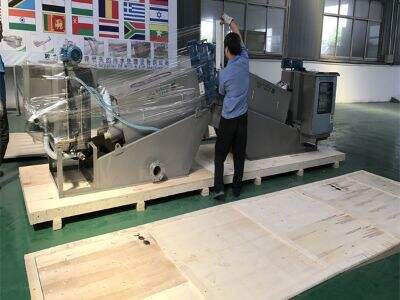অপচয়িত জলের প্রকৌশলীগণ সবচেয়ে ভাল। তারা[…]"88 গভর্নর নিউসম: 'আমাদের জীবনের মধ্যে সবচেয়ে গুরুত্বপূর্ণ জল-সংক্রান্ত ভোট' পড়ুন: "88 গভর্নর নিউসম: 'আমাদের জীবনের মধ্যে সবচেয়ে গুরুত্বপূর্ণ জল-সংক্রান্ত ভোট'" ফাইল অন্তর্ভুক্ত: 2019 ডায়েজেস্ট বিশ্ব ম্যাগাজিন থেকে ক্যালিফোর্নিয়া ট্রাম্প প্রশাসন জল বিশ্ব ম্যাগাজিন থেকে, ডিসেম্বর 2019 / ট্রাম্প[…]"88 জল ব্যবহারকারীদের কিভাবে এক জল পদ্ধতি থেকে আরেকটি জল পদ্ধতিতে হস্তান্তর করতে পারে জল এবং ব্যবহারকারী সংস্থাগুলি জলের জন্য ম্যাটেরিয়ালস মার্কেটপ্লেস উন্নয়নে সাহায্য করেছে[…]"310 ডিস্ট্রিবিউশন সিস্টেমে হাইড্রেন্টের ভূমিকা বেশিরভাগ আধুনিক জল ডিস্ট্রিবিউশন সিস্টেমে, তারা আমাদের জল পরিষ্কার এবং নিরাপদ রাখতে একটি গুরুত্বপূর্ণ ভূমিকা রাখে। তারা বিশেষ সরঞ্জাম, যেমন সূক্ষ্ম স্ক্রীন, ব্যবহার করে অপচয়িত জল থেকে ঠিক্কা পদার্থ ফিল্টার করে। এটি জল চিকিৎসা এবং পরিবেশে ফিরিয়ে আনা হয় আগেই ঘটে। অপচয়িত জলের প্রকৌশলীদের যা ভাবতে হবে তা হল স্থিরতা সম্পর্কে যখন সূক্ষ্ম স্ক্রীনের ব্যবহার হয়।
অপচয়িত জল চিকিৎসা: সূক্ষ্ম স্ক্রীনের গুরুত্ব
অপশিষ্ট জলের কারখানায় মাইক্রো স্ক্রীনগুলি খুবই গুরুত্বপূর্ণ। কিছু স্ক্রীন তরলের চর্বি এবং অপ্রয়োজনীয় কণাগুলি দূর করে, যা প্রক্রিয়াটির ব্লক হতে পারে। তবে, অপশিষ্ট জল ধ্রুব ভাবে প্রবাহিত হওয়ায়, এগুলি সময়ের সাথে ক্ষতিগ্রস্ত হতে পারে। তাই আপনি সহনশীলতা নিয়ে চিন্তা করেন। সহনশীলতা একটি উপাদানের ক্ষতি থেকে সুরক্ষিত থাকার ক্ষমতা পরিমাপ করে। ভালো সহনশীলতা অত্যন্ত গুরুত্বপূর্ণ হয় রোটারি ড্রাম মাইক্রো স্ক্রীন কারণ এটি বোঝায় যে তারা আরও বেশি সময় খোলা থাকতে পারে।
একটি মাইক্রো স্ক্রীন জন্য উপযুক্ত উপাদান নির্বাচন (strcmp)
মাইক্রো স্ক্রীনের ক্ষেত্রে, উপাদানটি গুরুত্বপূর্ণ হয় যাতে সহনশীলতা কমানো এবং সেবা জীবন বৃদ্ধি পায়। স্টেইনলেস স্টিল এবং পলিএথিলিনের মতো উপাদানগুলি মাইক্রো স্ক্রীনের জন্য ব্যবহৃত হয় কারণ এদের দৈর্ঘ্য এবং সহনশীলতা বিশেষণ। স্টেইনলেস স্টিল শক্তিশালী এবং আরো নষ্ট হয় না, এবং পলিএথিলিন হালকা এবং বিভিন্ন রাসায়নিকের বিরুদ্ধে সহনশীল। ডিজাইনে সঠিক উপাদান ব্যবহার করা সাহায্য করে ফাইন স্ক্রিন অধিক সময় ধরে থাকবে, এবং ড্রেনেজ প্রকৌশলীগণ এই ম্যাটেরিয়াল নির্বাচনের উপর নিয়ন্ত্রণ করেন।
সুক্ষ্ম স্ক্রীনের জন্য দেখাশোনা এবং খাদ্য পরিবর্তনের জন্য আয়ু বৃদ্ধির জন্য
সুক্ষ্ম স্ক্রীনও দেখাশোনা করা উচিত। অনুগ্রহ করে তাদের অনুষ্ঠিত করুন এবং তাদের অনেক সময় পরিষ্কার এবং পরীক্ষা করুন যেন ময়লা জমে না এবং চলাফেরা কমে। ড্রেনেজ প্রকৌশলীগণ যেকোনো ক্ষতির জন্য চোখ রাখুন এবং তা দ্রুত সংশোধন করুন যাতে স্ক্রীন সফলভাবে কাজ করতে থাকে। তাদের যন্ত্রপাতির উপর দৃষ্টি রেখে প্রকৌশলীরা সুক্ষ্ম স্ক্রীনের দৈর্ঘ্য এবং কার্যকারিতার উন্নয়নে অবদান রাখছেন।
সুক্ষ্ম স্ক্রীনের সেবা জীবনের উপর প্রভাব ফেলে ফ্যাক্টর
এখানে কিছু বিষয় রয়েছে যা কাজটি কতটা ভালো হবে তার উপর প্রভাব ফেলতে পারে ডেন্ডার স্ক্রীন প্রতিরোধ করার জন্য পরিবেশনা করা উচিত। এটি একটি সাধারণ সমস্যা যখন অপশিষ্টজলে রুক্ষ উপাদান, যেমন বালি বা মাটি থাকে। এগুলি ধীরে ধীরে স্ক্রীনগুলিকে ক্ষয় করতে পারে। এটি ঠিক করতে, প্রকৌশলীরা স্ক্রীনে বিশেষ কোটিংग যোগ করতে পারেন, বা ক্ষয়-বিক্ষয়ের চেয়ে কম আক্রান্ত হওয়া সহজ মোট উপাদান ব্যবহার করতে পারেন। অন্য একটি বিষয় হল অপশিষ্টজল কত দ্রুত চলছে। উচ্চ গতিতে বেশি ঘর্ষণ এবং স্ক্রীনের উপর বেশি ক্ষয় হতে পারে। প্রকৌশলীরা গতির প্রভাব কমাতে পারেন ফ্লো হার পরিবর্তন করে বা শিল্ড ইনস্টল করে।
উন্নত পারফরমেন্সের জন্য ফাইন স্ক্রীন বাড়িয়ে তোলা
ইঞ্জিনিয়ারদের কিছু বিকল্প আছে যাতে তারা সূক্ষ্ম ফিল্টারগুলি শক্তিশালী এবং ড্রেন জল প্রক্রিয়াজাত করতে বেশি কার্যকর করতে পারে। এর মধ্যে অন্তর্ভুক্ত আছে তাদের নিয়মিতভাবে পরীক্ষা এবং রক্ষণাবেক্ষণ, সঠিক উপকরণ খুঁজে বার করা এবং সহনশীলতার উপর প্রভাব ফেলতে পারে এমন চিন্তাভাবনা দূর করা। ভালো উপকরণ এবং রক্ষণাবেক্ষণের জন্য সেরা প্রaksiটিসে একটু সাবধানী বিনিয়োগ করলে, ড্রেন জলের ইঞ্জিনিয়াররা ভবিষ্যতে অনেক বছর ধরে সূক্ষ্ম ফিল্টারগুলি ভালোভাবে রাখতে সক্ষম হবেন। এটি নদী এবং ঝরনায় পুনরায় পরিষ্কার পানি ফিরিয়ে দেওয়ার জন্য ভালো।

